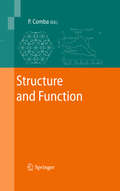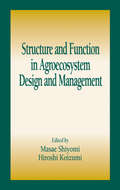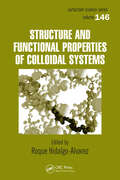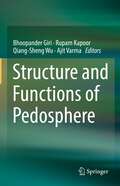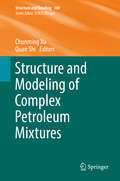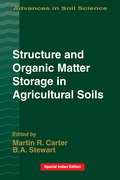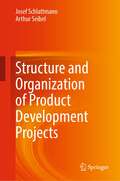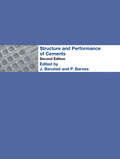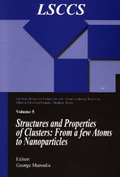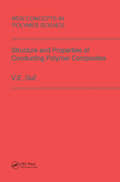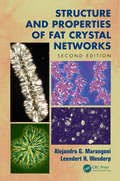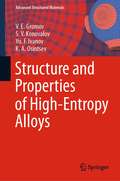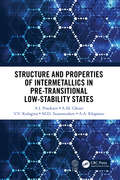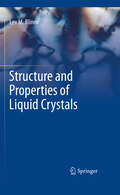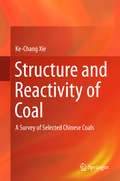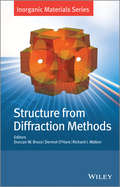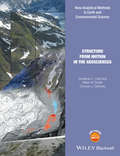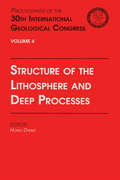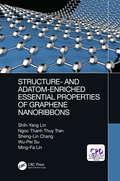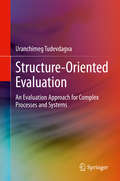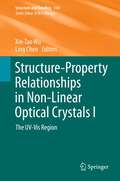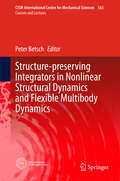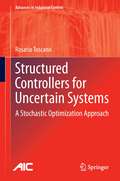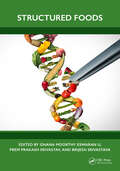- Table View
- List View
Structure and Function
by Peter CombaThe thermodynamic properties, reactivities and electronic properties of molecular compounds and materials depend on structure. Therefore, an important basis for progress is to fully appreciate and fundamentally understand the intimate relation between structure and function. Structure and Function describes various fundamental aspects of structures, dynamics and physics of molecules and materials. The approaches, data and models discussed include new theoretical developments, computational studies and experimental work from molecular chemistry to biology and materials science.
Structure and Function in Agroecosystem Design and Management (Advances in Agroecology)
by Masae Shiyomi Hiroshi KoizumiStructure and Function in Agroecosystem Design and Management presents an advanced discussion of the need to design agricultural systems that 1) increase reliance on biological interactions in agroecosystems as a means of decreasing dependence on the use of large quantities of agrochemicals and the consumption of fossil fuel energy and 2) continue
Structure and Functional Properties of Colloidal Systems (Surfactant Science)
by Roque Hidalgo-ÁlvarezIntegrating fundamental research with the technical applications of this rapidly evolving field, Structure and Functional Properties of Colloidal Systems clearly presents the connections between structure and functional aspects in colloid and interface science. It explores the physical fundamentals of colloid science, new developments of synthesis
Structure and Functions of Pedosphere
by Ajit Varma Qiang-Sheng Wu Bhoopander Giri Rupam KapoorThis edited volume covers all aspects of the latest research in the field of soil formation and its functioning, soil diversity, soil proteomics, the impact of anthropogenic activities on the pedosphere, plant-microbe interactions in the pedosphere, and factors influencing the formation and functioning of the soils. In the pedosphere, all forms of soils possess a particular type of structure and different organic and mineral components. Thus, the pedosphere as a whole plays a significant role in providing unique habitats for a vast diversity of life forms, developing a link between geological and biological substances circulation in the terrestrial ecosystems. In the processes making available vital mineral elements to plants and supporting human health as various trace elements in the lithosphere are accessed by people through the formation of soils and such soils are utilized for food production. With the depth of information on different aspects of soil, this extensive volume is a valuable resource for the researchers in the area of soil science, agronomy, agriculture, scientists in academia, crop consultants, policymakers, government from diverse disciplines, and graduate and post-graduate students in the area of soil and environmental science.
Structure and Modeling of Complex Petroleum Mixtures
by Chunming Xu Quan ShiChemical structure and bonding. The scope of the series spans the entire Periodic Table and addresses structure and bonding issues associated with all of the elements. It also focuses attention on new and developing areas of modern structural and theoretical chemistry such as nanostructures, molecular electronics, designed molecular solids, surfaces, metal clusters and supramolecular structures. Physical and spectroscopic techniques used to determine, examine and model structures fall within the purview of Structure and Bonding to the extent that the focus is on the scientific results obtained and not on specialist information concerning the techniques themselves. Issues associated with the development of bonding models and generalizations that illuminate the reactivity pathways and rates of chemical processes are also relevant. The individual volumes in the series are thematic. The goal of each volume is to give the reader, whether at a university or in industry, a comprehensive overview of an area where new insights are emerging that are of interest to a larger scientific audience.
Structure and Organic Matter Storage in Agricultural Soils
by B.A. Stewart M.R. CarterSoils comprise the largest pool of terrestrial carbon and therefore are an important component of carbon storage in the biosphere-atmosphere system. Structure and Organic Matter Storage in Agricultural Soils explores the mechanisms and processes involved in the storage and sequestration of carbon in soils. Focusing on agricultural soils - from tropical to semi-arid types - this new book provides an in-depth look at structure, aggregation, and organic matter retention in world soils. The first two sections of the book introduce readers to the basic issues and scientific concepts, including soil structure, underlying mechanisms and processes, and the importance of agroecosystems as carbon regulators. The third section provides detailed discussions of soil aggregation and organic matter storage under various climates, soil types, and soil management practices. The fourth section addresses current strategies for enhancing organic matter storage in soil, modelling techniques, and measurement methods.Throughout the book, the importance of the soil structure-organic matter storage relationship is emphasized. Anyone involved in soil science, agriculture, agronomy, plant science, or greenhouse gas and global change studies should understand this relationship. Structure and Organic Matter Storage in Agricultural Soils provides an ideal source of information not only on the soil structure-storage relationship itself, but also on key research efforts and direct applications related to the storage of organic matter in agricultural soils.
Structure and Organization of Product Development Projects
by Josef Schlattmann Arthur SeibelThis book conveys useful knowledge, skills and behaviour that an engineer who is responsible for product development/project management often needs, but which is not given enough attention in the usual engineering education. It goes beyond the specialist knowledge into the human domain, because technical and/or organisational difficulties are in fact always based on human problems. The book is aimed at professionals and managers working in the development of machines, apparatus, equipment and the like, including the responsible organizational managers.
Structure and Performance of Cements
by P. Barnes J. BenstedDrawing together a multinational team of authors, this second edition of Structure and Performance of Cements highlights the latest global advances in the field of cement technology. Three broad categories are covered: basic materials and methods, cement extenders, and techniques of examination. Within these categories consideration has been given
Structure and Properties of Clusters: from a few Atoms to Nanoparticles
by George MaroulisThis volume on Clusters brings together contributions from a large number of specialists. A central element for all contributions is the use of advanced computational methodologies and their application to various aspects of structure, reactivity and properties of clusters. The size of clusters varies from a few atoms to nanoparticles.
Structure and Properties of Conducting Polymer Composites
by V.E. GulThe development of the principles of electrically conductive polymer composites and the creation of a wide variety of such materials have had a significant influence on modern technology. This volume in the "New Concepts in Polymer Science" series is devoted to various aspects of the structure and properties of electrically conductive polymer composites. This monograph is an attempt to systematize modern ideas on the interconnection of the structure and properties of ECPCs. Specific attention is given to the influence of electric current on kinetics and the direction of chemical interactive processes between such systems and air oxygen. The book also contains a special chapter which is devoted to the practical applications of electrically conductive polymer composites. It should be of use and interest to researchers working in the field.
Structure and Properties of Fat Crystal Networks
by Alejandro G. Marangoni Leendert H. WesdorpLipid science and technology has grown exponentially since the turn of the millennium. The replacement of unhealthy fats in the foods we eat, and of petroleum-based ingredients in the cosmetics we use, is a top priority for consumers, government, and industry alike. Particularly for the food industry, removing trans fats and reducing saturated fat
Structure and Properties of High-Entropy Alloys (Advanced Structured Materials #107)
by V. E. Gromov S. V. Konovalov Yu. F. Ivanov K. A. OsintsevThis book provides an overview of high entropy alloys, explaining all the basics of this new class of materials that emerged at the beginning of the 21st: It begins with the basics of the manufacturing methods of high entropy alloys and discusses the mechanical properties and deformation mechanisms of high entropy alloys. Then the book addresses the stability of these alloys and explores the prospects of high entropy alloys for applications.This book is intended as an introduction for physicists and materials scientists who need to become familiar with high entropy alloys.
Structure and Properties of Intermetallics in Pre-Transitional Low-Stability States
by A.M. Glezer A.I. Potekaev V.V. Kulagin M.D. Starostenkov A.A. KlopotThis book is dedicated to the fundamental physical aspects of stability, the influence of structural defects on the properties and structural phase transformations of BCC alloys. The authors present patterns that occur in the structural-phase states of functional alloys with low stability or instability under thermal cycling effects. Structural-phase transformations and the physical laws governing the influence of the thermomechanical effect on the properties of alloys are examined to advance development of technological processes for processing functional materials. Features: Studies the correlation between structural phase states and changes in the physico-mechanical properties of intermetallic compounds Explores the influence of thermomechanical cycling on the properties of functional alloys Details low-stability pretransition states in alloys
Structure and Properties of Liquid Crystals
by Lev M. BlinovThis book introduces the most important concepts related to the structure and physical properties of liquid crystals, including some of the theoretical aspects. It consists of three parts: structure, physical properties, and electro-optic behavior.
Structure and Reactivity of Coal
by Ke-Chang XieThis book provides insights into the development and usage of coal in chemical engineering. The reactivity of coal in processes such as pyrolysis, gasification, liquefaction, combustion and swelling is related to its structural properties. Using experimental findings and theoretical analysis, the book comprehensively answers three crucial issues that are fundamental to the optimization of coal chemical conversions: What is the structure of coal? How does the underlying structure determine the reactivity of different types of coal? How does the structure of coal alter during coal conversion? This book will be of interest to both individual readers and institutions involved in teaching and research into chemical engineering and energy conversion technologies. It is aimed at advanced- level undergraduate students. The text is suitable for readers with a basic knowledge of chemistry, such as first-year undergraduate general science students. Higher-level students with an in-depth understanding of the chemistry of coal will also benefit from the book. It will provide a useful reference resource for students and university-level teachers, as well as practicing engineers.
Structure from Diffraction Methods
by Dermot O'Hare Richard I. Walton Duncan W. BruceInorganic materials show a diverse range of important properties that are desirable for many contemporary, real-world applications. Good examples include recyclable battery cathode materials for energy storage and transport, porous solids for capture and storage of gases and molecular complexes for use in electronic devices. An understanding of the function of these materials is necessary in order to optimise their behaviour for real applications, hence the importance of 'structure-property relationships'.The chapters presented in this volume deal with recent advances in the characterisation of crystalline materials. They include some familiar diffraction methods, thoroughly updated with modern advances. Also included are techniques that can now probe details of the three-dimensional arrangements of atoms in nanocrystalline solids, allowing aspects of disorder to be studied. Small-angle scattering, a technique that is often overlooked, can probe both ordered and disordered structures of materials at longer length scales than those probed by powder diffraction methods.Addressing both physical principals and recent advances in their applications, Structure from Diffraction Methods covers: Powder DiffractionX-Ray and Neutron Single-Crystal DiffractionPDF Analysis of NanoparticlesElectron CrystallographySmall-Angle ScatteringIdeal as a complementary reference work to other volumes in the series (Local Structural Characterisation and Multi Length-Scale Characterisation), or as an examination of the specific characterisation techniques in their own right, Structure from Diffraction Methods is a valuable addition to the Inorganic Materials Series.
Structure from Motion in the Geosciences (Analytical Methods in Earth and Environmental Science)
by Mark W. Smith Jonathan L. Carrivick Duncan J. QuinceyStructure from Motion with Multi View Stereo provides hyperscale landform models using images acquired from standard compact cameras and a network of ground control points. The technique is not limited in temporal frequency and can provide point cloud data comparable in density and accuracy to those generated by terrestrial and airborne laser scanning at a fraction of the cost. It therefore offers exciting opportunities to characterise surface topography in unprecedented detail and, with multi-temporal data, to detect elevation, position and volumetric changes that are symptomatic of earth surface processes. This book firstly places Structure from Motion in the context of other digital surveying methods and details the Structure from Motion workflow including available software packages and assessments of uncertainty and accuracy. It then critically reviews current usage of Structure from Motion in the geosciences, provides a synthesis of recent validation studies and looks to the future by highlighting opportunities arising from developments in allied disciplines. This book will appeal to academics, students and industry professionals because it balances technical knowledge of the Structure from Motion workflow with practical guidelines for image acquisition, image processing and data quality assessment and includes case studies that have been contributed by experts from around the world.
Structure of Materials: An Introduction to Crystallography, Diffraction and Symmetry
by Marc De Graef Michael E. MchenryThis highly readable, popular textbook for upper undergraduates and graduates comprehensively covers the fundamentals of crystallography and symmetry, applying these concepts to a large range of materials. New to this edition are more streamlined coverage of crystallography, additional coverage of magnetic point group symmetry and updated material on extraterrestrial minerals and rocks. New exercises at the end of chapters, plus over 500 additional exercises available online, allow students to check their understanding of key concepts and put into practice what they have learnt. Over 400 illustrations within the text help students visualise crystal structures and more abstract mathematical objects, supporting more difficult topics like point group symmetries. Historical and biographical sections add colour and interest by giving an insight into those who have contributed significantly to the field. Supplementary online material includes password-protected solutions, over 100 crystal structure data files, and Powerpoints of figures from the book.
Structure of the Lithosphere and Deep Processes: Proceedings of the 30th International Geological Congress, Volume 4
by Hong DaweiThis book is a collection of papers presented in the 30th International Geological Congress, held in Beijing, on structure of the lithosphere and deep processes. The papers deal with topics on the measurement of P-wave velocities in rocks, and elastic properties of crust and upper mantle.
Structure- and Adatom-Enriched Essential Properties of Graphene Nanoribbons
by Shih-Yang Lin Sheng-Lin Chang Wu-Pei Su Ming-Fa Lin Ngoc Thanh Thuy TranStructure- and Adatom-Enriched Essential Properties of Graphene Nanoribbons offers a systematic review of the feature-rich essential properties in emergent graphene nanoribbons, covering mainstream theoretical and experimental research. It includes a wide range of 1D systems; namely, armchair and zigzag graphene nanoribbons with and without hydrogen terminations, curved and zipped graphene nanoribbons, folded graphene nanoribbons, carbon nanoscrolls, bilayer graphene nanoribbons, edge-decorated graphene nanoribbons, and alkali-, halogen-, Al-, Ti, and Bi-absorbed graphene nanoribbons. Both multiorbital chemical bondings and spin arrangements, which are responsible for the diverse phenomena, are explored in detail. First-principles calculations are developed to thoroughly describe the physical, chemical, and material phenomena and concise images explain the fundamental properties. This book examines in detail the application and theory of graphene nanoribbons, offering a new perspective on up-to-date mainstream theoretical and experimental research.
Structure-Oriented Evaluation: An Evaluation Approach for Complex Processes and Systems
by Uranchimeg TudevdagvaThis book introduces a new branch of evaluation theory, where evaluation and score calculation is embedded into general measure theory, as is typical in geometry, probability theory and reliability theory. The author describes the theoretical background of new evaluation model for complex processes, where interests of involved groups are considered as multi-players of evaluation process. Readers will learn how the logical structure of a process/system can be included into an evaluation. The author applies these techniques not only to the visualization of evaluation goals, but also the designed logical structure becomes the basis for calculation of evaluation scores. Various examples are provides to demonstrate the implementation of the methods.
Structure-Property Relationships in Non-Linear Optical Crystals II
by Xin-Tao Wu Ling ChenXiao-Ming Jiang, Sheng-Ping Guo, Hui-Yi Zeng, Ming-Jian Zhang, Guo-Cong Guo: Large Crystal Growth and New Crystal Exploration of Mid-Infrared Second-Order Nonlinear Optical Materials.- Kechen Wu: Simulation and Design of Infrared Second-Order Nonlinear Optical Materials in Metal Cluster Compounds.- Chaoyang Tu: The Recent Development Of SRS and SRS SF- conversion Laser Crystal.- Hua-Jun Zhao, Xin-Tao Wu, Li-Ming Wu: Exploration of New Second-Order Nonlinear Optical Compounds Containing Main Group Elements.
Structure-preserving Integrators in Nonlinear Structural Dynamics and Flexible Multibody Dynamics
by Peter BetschThis book focuses on structure-preserving numerical methodsfor flexible multibody dynamics, including nonlinear elastodynamics andgeometrically exact models for beams and shells. It also deals with the newlyemerging class of variational integrators as well as Lie-group integrators. Itdiscusses two alternative approaches to the discretization in space ofnonlinear beams and shells. Firstly, geometrically exact formulations, whichare typically used in the finite element community and, secondly, the absolutenodal coordinate formulation, which is popular in the multibody dynamicscommunity. Concerning the discretization in time, the energy-momentum methodand its energy-decaying variants are discussed. It also addresses a number ofissues that have arisen in the wake of the structure-preserving discretizationin space. Among them are the parameterization of finite rotations, theincorporation of algebraic constraints and the computer implementation of thevarious numerical methods. The practical application of structure-preservingmethods is illustrated by a number of examples dealing with, among others,nonlinear beams and shells, large deformation problems, long-term simulationsand coupled thermo-mechanical multibody systems. In addition it links novel timeintegration methods to frequently used methods in industrial multibody systemsimulation.
Structured Controllers for Uncertain Systems
by Rosario ToscanoStructured Controllers for Uncertain Systems focuses on the development of easy-to-use design strategies for robust low-order or fixed-structure controllers (particularly the industrially ubiquitous PID controller). These strategies are based on a recently-developed stochastic optimization method termed the "Heuristic Kalman Algorithm" (HKA) the use of which results in a simplified methodology that enables the solution of the structured control problem without a profusion of user-defined parameters. An overview of the main stochastic methods employable in the context of continuous non-convex optimization problems is also provided and various optimization criteria for the design of a structured controller are considered; H , H2, and mixed H2/H each merits a chapter to itself. Time-domain-performance specifications can be easily incorporated in the design.
Structured Foods
by Prem Prakash Srivastav Eswaran U, Gnana Moorthy Brijesh SrivastavaStructured Foods is an important reference that discusses the recent research trends on structural development in various foods. This book covers different tools and food engineering techniques such as encapsulation, 3D and 4D printing, imaging techniques, and clean meat technology. It discusses how various foods can be broken down and manipulated at the molecular level to improve their quality, safety, and healthfulness. It describes the structuring of components like starch, proteins, and polysaccharides and the stability and bioavailability of different food structures. This is a useful reference for researchers and industry experts in food technology, food engineering, and food processing.The work addresses critical food-related issues that need to be tackled, including harvesting enough food to feed the global population, improving food sustainability, reducing food waste and pollution, and improving human health. Further, it focuses on the new scientific technologies being applied by scientists for an improved food system. The book is an important resource for all stakeholders in the debate about the future of our foods in the spheres of academic, industrial, and government policy.
